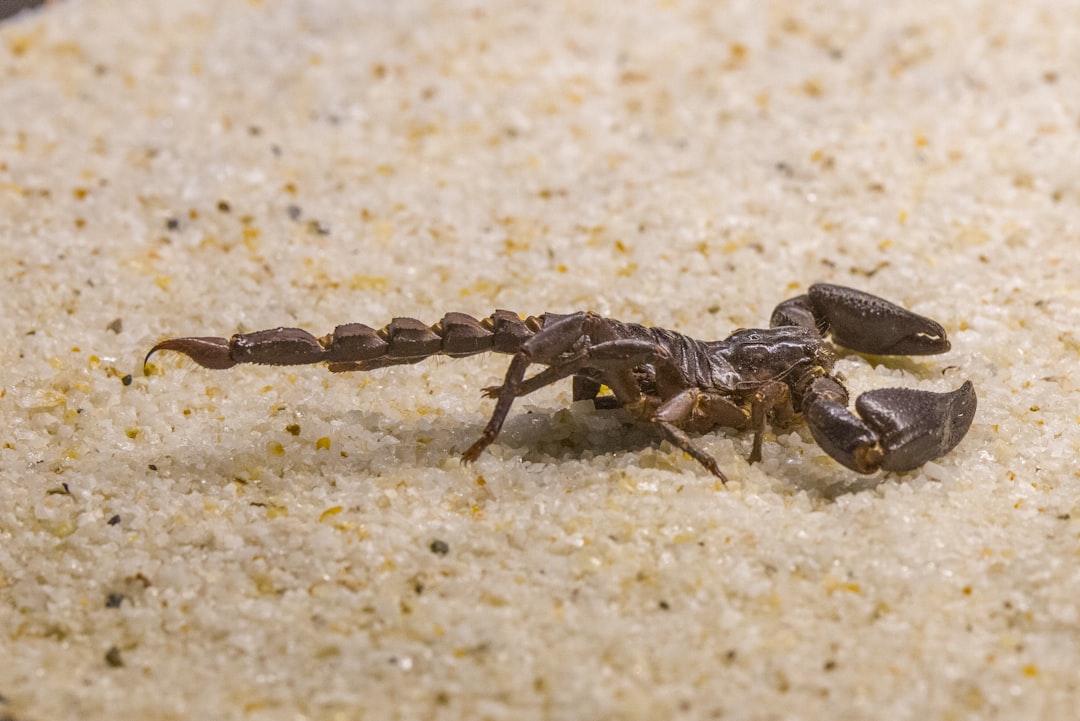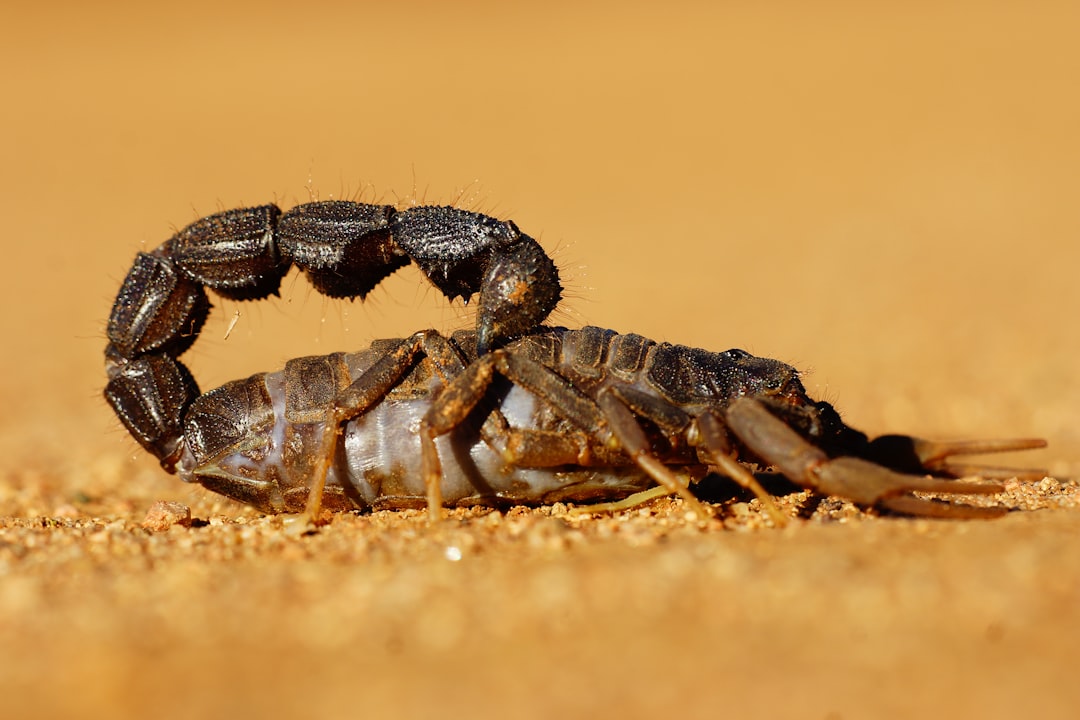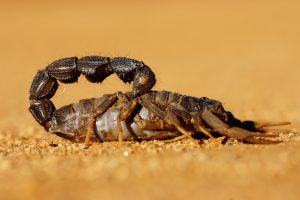Scorpion control in Oro Valley is a critical aspect of managing these arachnids' populations, given their preference for warm, arid environments with shelter and food sources. Effective population management requires understanding scorpions' life cycles, such as their live birth reproduction, and how environmental factors like humidity and food availability influence their behavior. Homeowners can minimize scorpion infestation risks by sealing entry points, reducing outdoor lighting at night, maintaining clean yards, and eliminating hiding spots. Integrated pest management strategies include regular garden maintenance, sticky traps or baits, dehumidifiers, and professional pest control services when necessary. Community education on scorpion behavior and responsible landscaping practices that create barriers and selective planting contribute to sustainable scorpion control. This comprehensive approach ensures a balance between ecological integrity and community safety in Oro Valley while emphasizing the importance of environmental stewardship and practical daily habits for effective scorpion population management.
Scorpions are a common presence in Oro Valley, Arizona, known for their venomous sting and nocturnal habits. This article delves into the intricacies of scorpion breeding behaviors and provides homeowners and businesses with strategies to prevent infestations. Understanding these arachnids’ biology is crucial for developing effective control measures. We explore the habitats that scorpions favor in Oro Valley, the optimal conditions they require for reproduction, and the importance of proactive scorpion control to safeguard your environment. By examining mitigation techniques and extermination methods tailored to the local ecosystem, readers can implement long-term solutions to manage these creatures responsibly and safely.
- Understanding Scorpion Biology: Key Factors Influencing Breeding Habits in Oro Valley
- Optimal Habitats for Scorpions in Oro Valley: Identifying and Mitigating High-Risk Areas
- Scorpion Control Strategies: Proactive Measures to Prevent Infestations in Residential Areas
- Effective Scorpion Extermination Techniques for Oro Valley Homes and Businesses
- Long-Term Solutions for Scorpion Management in Oro Valley's Ecosystem
Understanding Scorpion Biology: Key Factors Influencing Breeding Habits in Oro Valley

Scorpion breeding habits are influenced by a multitude of factors, which are critical to understand for effective scorpion control in Oro Valley. These arachnids thrive in environments that provide ample shelter and a consistent supply of food. The region’s climate, with its specific temperature ranges and humidity levels, plays a pivotal role in determining the success of their breeding cycles. Scorpions are ectothermic, relying on external sources for heat regulation; thus, Oro Valley’s warm, arid conditions are particularly conducive to their survival.
Understanding the life cycle of scorpions is essential for implementing targeted scorpion control measures. Females often give birth to live young, a behavior that contrasts with other species that lay eggs. This trait necessitates a focus on controlling adult populations to prevent rapid expansion. The availability of prey items such as insects and spiders also affects breeding patterns; areas rich in these food sources can lead to increased scorpion activity. Additionally, scorpions require a certain level of humidity to maintain their cuticle’s integrity, which means that water sources, whether natural or man-made, can serve as attractants for scorpion colonization. Tailored environmental management and monitoring can help disrupt the breeding cycles, making integrated pest management and scorpion control strategies more effective in Oro Valley.
Optimal Habitats for Scorpions in Oro Valley: Identifying and Mitigating High-Risk Areas

Scorpions, particularly the species commonly found in Oro Valley, thrive in environments that offer both shelter and a plentiful supply of prey. These arid regions, characterized by their rocky terrain and sparse vegetation, are ideal habitats for scorpions as they provide protection from predators and harsh weather conditions. To effectively manage and control scorpion populations in residential areas, it’s crucial to understand the factors that attract these creatures. High-risk areas for scorpion infestations often include locations with abundant debris, rock piles, or woodpiles, which serve as hiding spots during the day and hunting grounds at night. Mitigating high-risk areas involves regular clean-up of yard clutter and ensuring that outdoor lights are not inadvertently attracting insects—scorpions’ primary food source. Employing scorpion control measures such as sealing entry points to homes, keeping the yard free of hiding spots, and removing any unnecessary items that could serve as shelters, can significantly reduce the likelihood of an infestation. Additionally, maintaining a well-kept garden and regularly inspecting the premises can help in deterring scorpions from making their home too close for comfort. By understanding the optimal habitats for scorpions and actively managing one’s environment to mitigate risks, residents of Oro Valley can significantly lower the chances of encountering these creatures in and around their homes.
Scorpion Control Strategies: Proactive Measures to Prevent Infestations in Residential Areas

Scorpion infestations can be a significant concern for Oro Valley residents, as these arachnids seek shelter in homes during extreme weather conditions. Effective scorpion control begins with understanding their breeding habits and preferred environments. Scorpions typically enter dwellings through cracks and crevices in search of prey like insects and spiders, or to escape environmental stressors like drought or high temperatures. To prevent infestations, it’s crucial to seal potential entry points around the home, including windows, doors, and utility lines. Keeping outdoor lighting minimal at night can reduce attraction to these areas, as scorpions are nocturnal and drawn to light sources.
Implementing a multi-faceted scorpion control strategy is key. Regular maintenance of gardens and landscapes, such as removing debris and keeping vegetation trimmed, eliminates hiding spots. Employing sticky traps or baits strategically placed can help monitor scorpion activity and guide pest control professionals in creating a targeted treatment plan. Additionally, maintaining cleanliness both indoors and out, including the removal of food sources for scorpions, deters their presence. Dehumidifiers or proper ventilation within the home can also create an environment less hospitable to these creatures. By combining these proactive measures with professional pest control services when necessary, residents of Oro Valley can significantly reduce the risk of scorpion infestations and ensure a safer living environment.
Effective Scorpion Extermination Techniques for Oro Valley Homes and Businesses

In the arid climate of Oro Valley, Arizona, effective scorpion control measures are essential for both residential and commercial properties to prevent infestations. Scorpions seek shelter in environments that provide them with protection from predators and harsh weather conditions, often finding their way into homes and businesses through cracks and crevices. The first line of defense in scorpion control involves sealing potential entry points, including gaps around windows, doors, and utilities. Regular maintenance and weather stripping can significantly reduce the likelihood of scorpions entering a structure.
Beyond physical barriers, employing strategic lighting is crucial to deterring scorpions. These nocturnal pests are attracted to dark, undisturbed areas, and exterior lighting can make these spaces less hospitable. Additionally, maintaining clean and tidy environments both indoors and out minimizes the presence of their food sources, such as insects and spiders, which in turn reduces scorpion populations. For more aggressive scorpion control measures, professional pest management companies in Oro Valley offer targeted treatments that can effectively eliminate existing scorpion populations. These professionals use a combination of techniques, including monitoring, identification, and application of appropriate insecticides within and around structures to control scorpion infestations. It is advisable to engage with these experts to implement a customized scorpion control plan tailored to the specific needs of each property, ensuring the safety of occupants and the efficacy of the pest management strategy.
Long-Term Solutions for Scorpion Management in Oro Valley's Ecosystem

In Oro Valley, where arid conditions and rocky landscapes provide natural habitats for scorpions, implementing long-term solutions for scorpion management is crucial for maintaining a harmonious ecosystem. Effective scorpion control strategies often involve habitat modification to reduce the likelihood of scorpions entering human dwellings. This includes minimizing their hiding places by keeping yards and gardens clean and well-lit, removing debris and rock piles where scorpions can hide during the day, and ensuring that foliage is not directly abutting against the structure of homes. Additionally, maintaining a clean environment indoors by regularly vacuuming and keeping areas free of clutter where scorpions might seek refuge can significantly deter their presence.
Another key aspect of long-term scorpion control is to manage the vegetation around residential areas, as certain types of plants and shrubs are more prone to harboring scorpions. Landscaping with gravel barriers between vegetation and homes can also act as a deterrent, making it more difficult for scorpions to traverse towards living spaces. Furthermore, employing eco-friendly pesticides, when necessary and in accordance with local regulations, can help control scorpion populations without posing risks to the environment or human health. These integrated pest management practices, combined with community awareness and education on scorpion behavior and prevention, form a comprehensive approach for effective scorpion control in Oro Valley’s ecosystem over the long term.
In conclusion, the study of scorpion breeding habits in Oro Valley provides critical insights necessary for effective scorpion control and infestation prevention. By understanding their optimal habitats and implementing proactive measures, residents can significantly reduce the risk of scorpion encounters. The strategies outlined in this article for controlling and exterminating scorpions, when combined with long-term management solutions, present a comprehensive approach to maintaining a safe environment. Homeowners and businesses in Oro Valley are encouraged to adopt these practices to ensure a harmonious coexistence with the local wildlife while safeguarding their properties from these arachnids.
